A Comparative Study of Leadership Theories: Transformational vs. LMX
VerifiedAdded on 2023/03/21
|10
|2399
|46
Essay
AI Summary
This essay provides a comprehensive comparison of Transformational Leadership Theory and Leader-Member Exchange (LMX) Theory. It delves into the core components of transformational leadership, including inspirational motivation, intellectual stimulation, idealized influence, and individualized consideration, while also addressing criticisms of the theory. The essay further explains the stages of LMX theory—role-taking, role-making, and routinization—highlighting the differences between in-groups and out-groups. The comparison explores the similarities, such as their focus on employee support and change management, and contrasts, such as their approaches to employee treatment. The essay concludes that while transformational leadership emphasizes ethical behavior and equal treatment, LMX theory differentiates employees based on perceived competence, affecting team dynamics and morale. Desklib offers numerous resources and solved assignments for students studying leadership and management.
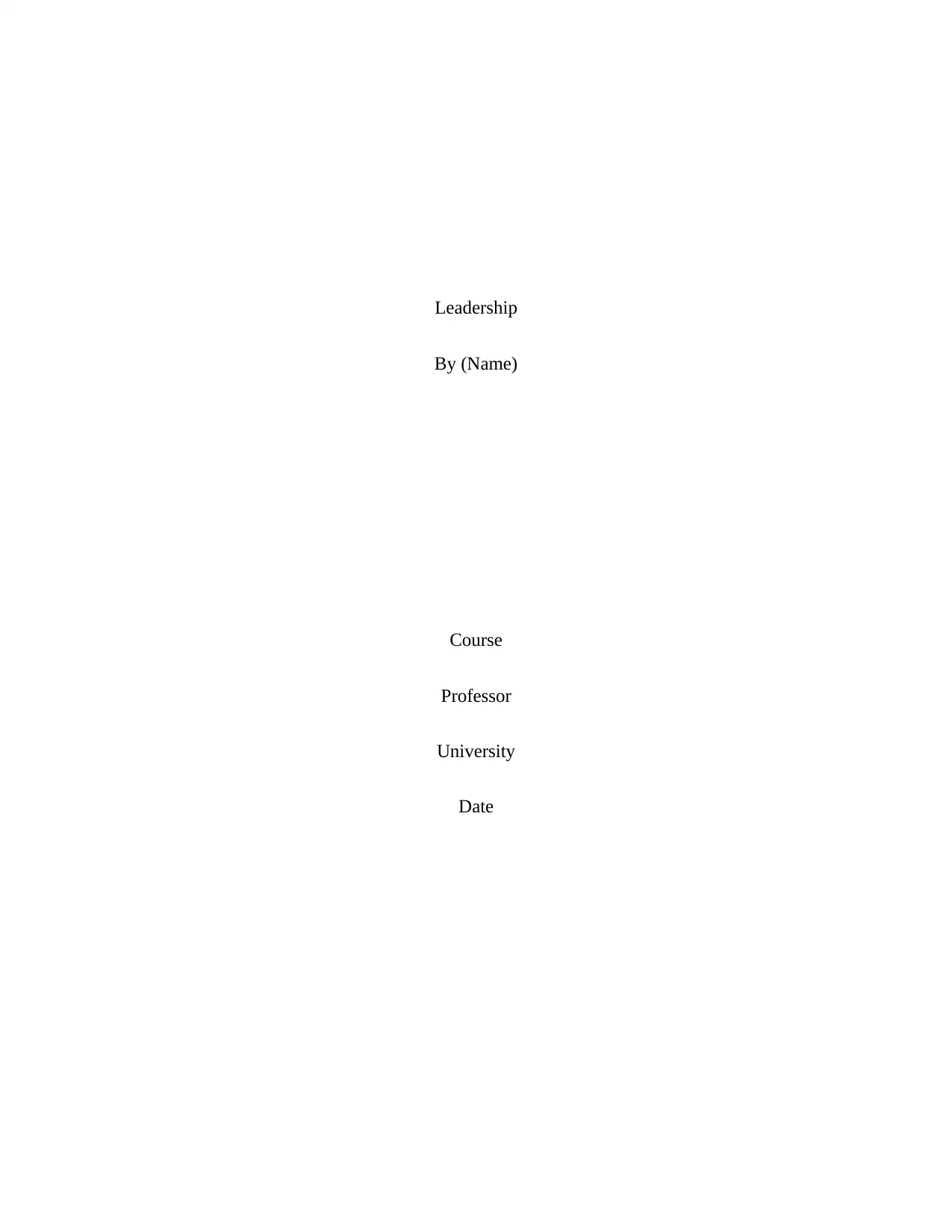
Leadership
By (Name)
Course
Professor
University
Date
By (Name)
Course
Professor
University
Date
Paraphrase This Document
Need a fresh take? Get an instant paraphrase of this document with our AI Paraphraser
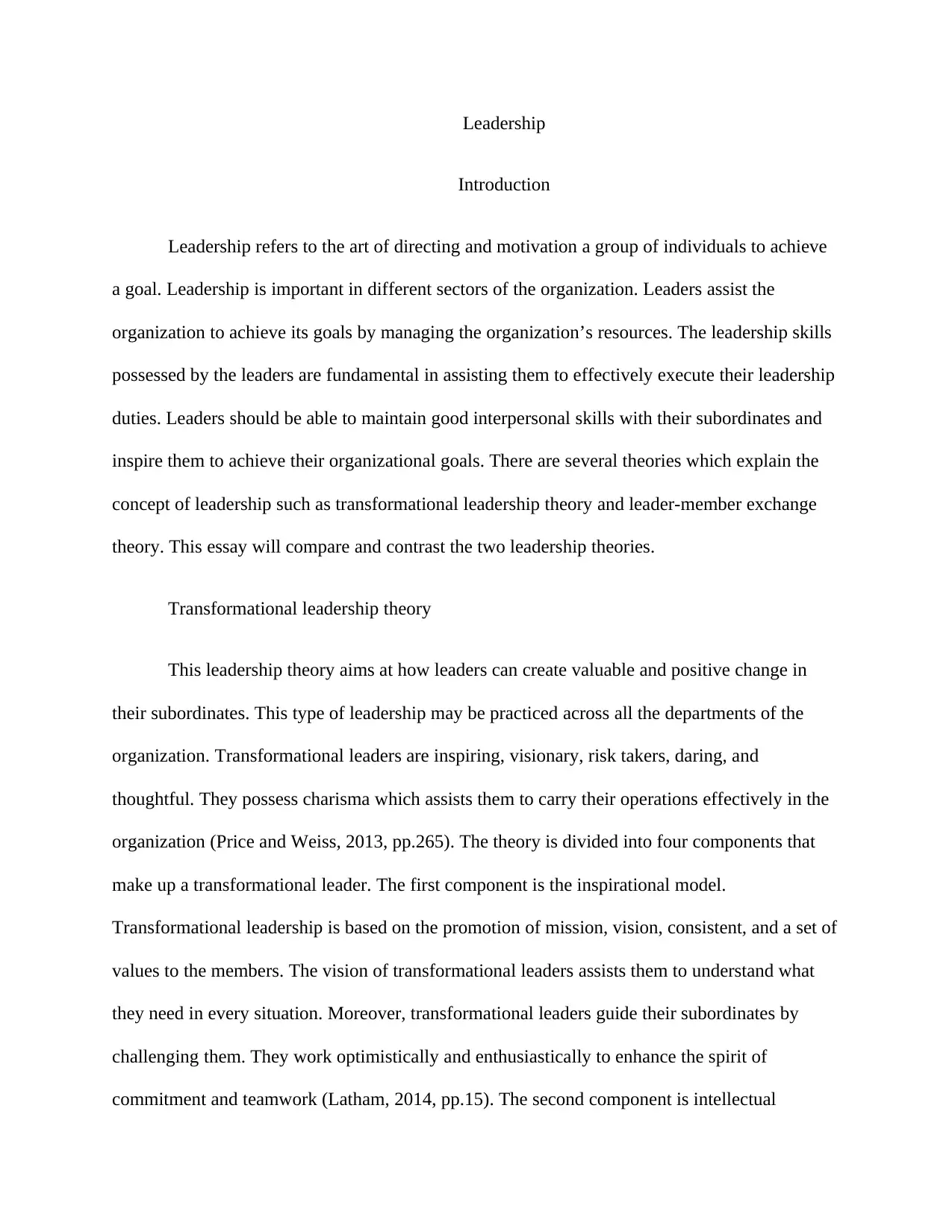
Leadership
Introduction
Leadership refers to the art of directing and motivation a group of individuals to achieve
a goal. Leadership is important in different sectors of the organization. Leaders assist the
organization to achieve its goals by managing the organization’s resources. The leadership skills
possessed by the leaders are fundamental in assisting them to effectively execute their leadership
duties. Leaders should be able to maintain good interpersonal skills with their subordinates and
inspire them to achieve their organizational goals. There are several theories which explain the
concept of leadership such as transformational leadership theory and leader-member exchange
theory. This essay will compare and contrast the two leadership theories.
Transformational leadership theory
This leadership theory aims at how leaders can create valuable and positive change in
their subordinates. This type of leadership may be practiced across all the departments of the
organization. Transformational leaders are inspiring, visionary, risk takers, daring, and
thoughtful. They possess charisma which assists them to carry their operations effectively in the
organization (Price and Weiss, 2013, pp.265). The theory is divided into four components that
make up a transformational leader. The first component is the inspirational model.
Transformational leadership is based on the promotion of mission, vision, consistent, and a set of
values to the members. The vision of transformational leaders assists them to understand what
they need in every situation. Moreover, transformational leaders guide their subordinates by
challenging them. They work optimistically and enthusiastically to enhance the spirit of
commitment and teamwork (Latham, 2014, pp.15). The second component is intellectual
Introduction
Leadership refers to the art of directing and motivation a group of individuals to achieve
a goal. Leadership is important in different sectors of the organization. Leaders assist the
organization to achieve its goals by managing the organization’s resources. The leadership skills
possessed by the leaders are fundamental in assisting them to effectively execute their leadership
duties. Leaders should be able to maintain good interpersonal skills with their subordinates and
inspire them to achieve their organizational goals. There are several theories which explain the
concept of leadership such as transformational leadership theory and leader-member exchange
theory. This essay will compare and contrast the two leadership theories.
Transformational leadership theory
This leadership theory aims at how leaders can create valuable and positive change in
their subordinates. This type of leadership may be practiced across all the departments of the
organization. Transformational leaders are inspiring, visionary, risk takers, daring, and
thoughtful. They possess charisma which assists them to carry their operations effectively in the
organization (Price and Weiss, 2013, pp.265). The theory is divided into four components that
make up a transformational leader. The first component is the inspirational model.
Transformational leadership is based on the promotion of mission, vision, consistent, and a set of
values to the members. The vision of transformational leaders assists them to understand what
they need in every situation. Moreover, transformational leaders guide their subordinates by
challenging them. They work optimistically and enthusiastically to enhance the spirit of
commitment and teamwork (Latham, 2014, pp.15). The second component is intellectual
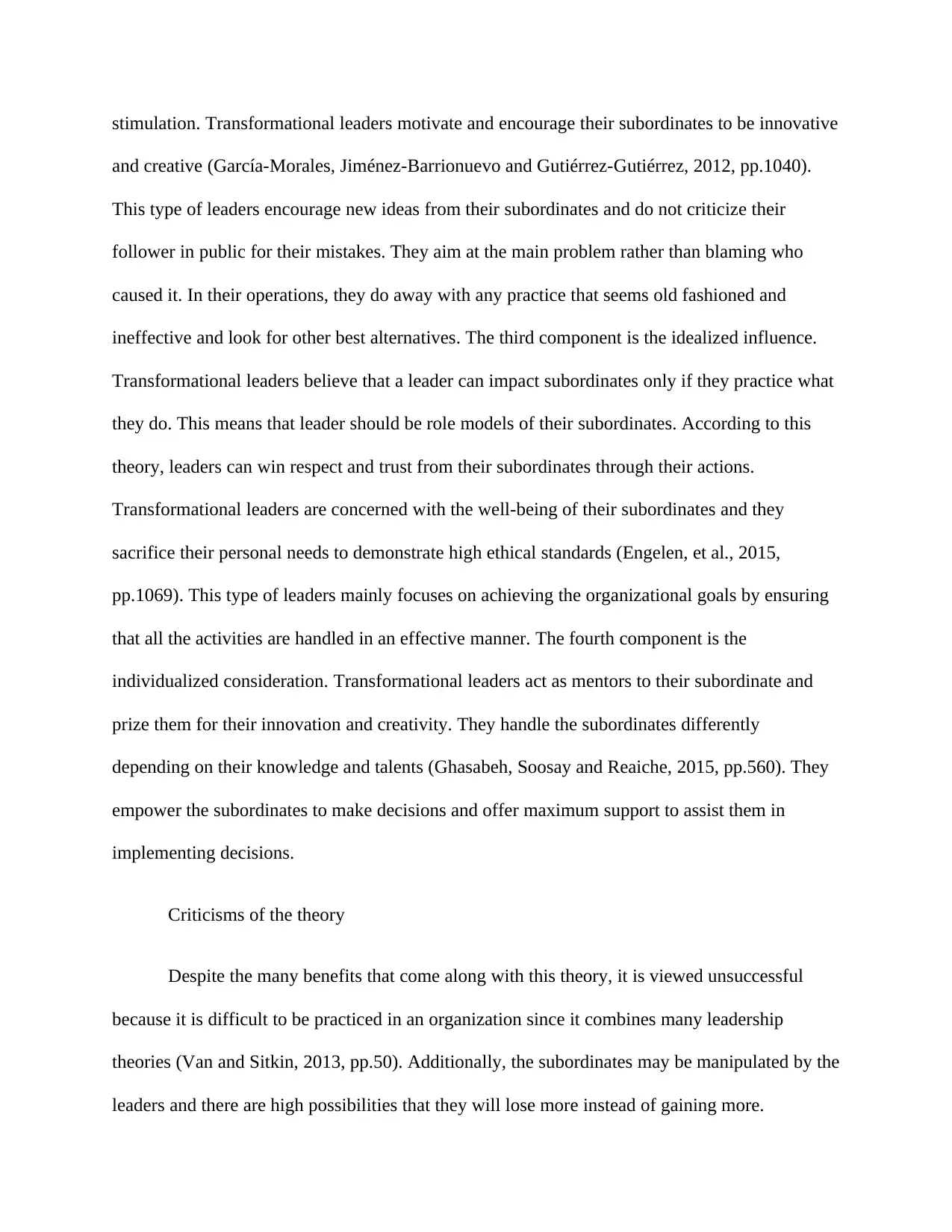
stimulation. Transformational leaders motivate and encourage their subordinates to be innovative
and creative (García-Morales, Jiménez-Barrionuevo and Gutiérrez-Gutiérrez, 2012, pp.1040).
This type of leaders encourage new ideas from their subordinates and do not criticize their
follower in public for their mistakes. They aim at the main problem rather than blaming who
caused it. In their operations, they do away with any practice that seems old fashioned and
ineffective and look for other best alternatives. The third component is the idealized influence.
Transformational leaders believe that a leader can impact subordinates only if they practice what
they do. This means that leader should be role models of their subordinates. According to this
theory, leaders can win respect and trust from their subordinates through their actions.
Transformational leaders are concerned with the well-being of their subordinates and they
sacrifice their personal needs to demonstrate high ethical standards (Engelen, et al., 2015,
pp.1069). This type of leaders mainly focuses on achieving the organizational goals by ensuring
that all the activities are handled in an effective manner. The fourth component is the
individualized consideration. Transformational leaders act as mentors to their subordinate and
prize them for their innovation and creativity. They handle the subordinates differently
depending on their knowledge and talents (Ghasabeh, Soosay and Reaiche, 2015, pp.560). They
empower the subordinates to make decisions and offer maximum support to assist them in
implementing decisions.
Criticisms of the theory
Despite the many benefits that come along with this theory, it is viewed unsuccessful
because it is difficult to be practiced in an organization since it combines many leadership
theories (Van and Sitkin, 2013, pp.50). Additionally, the subordinates may be manipulated by the
leaders and there are high possibilities that they will lose more instead of gaining more.
and creative (García-Morales, Jiménez-Barrionuevo and Gutiérrez-Gutiérrez, 2012, pp.1040).
This type of leaders encourage new ideas from their subordinates and do not criticize their
follower in public for their mistakes. They aim at the main problem rather than blaming who
caused it. In their operations, they do away with any practice that seems old fashioned and
ineffective and look for other best alternatives. The third component is the idealized influence.
Transformational leaders believe that a leader can impact subordinates only if they practice what
they do. This means that leader should be role models of their subordinates. According to this
theory, leaders can win respect and trust from their subordinates through their actions.
Transformational leaders are concerned with the well-being of their subordinates and they
sacrifice their personal needs to demonstrate high ethical standards (Engelen, et al., 2015,
pp.1069). This type of leaders mainly focuses on achieving the organizational goals by ensuring
that all the activities are handled in an effective manner. The fourth component is the
individualized consideration. Transformational leaders act as mentors to their subordinate and
prize them for their innovation and creativity. They handle the subordinates differently
depending on their knowledge and talents (Ghasabeh, Soosay and Reaiche, 2015, pp.560). They
empower the subordinates to make decisions and offer maximum support to assist them in
implementing decisions.
Criticisms of the theory
Despite the many benefits that come along with this theory, it is viewed unsuccessful
because it is difficult to be practiced in an organization since it combines many leadership
theories (Van and Sitkin, 2013, pp.50). Additionally, the subordinates may be manipulated by the
leaders and there are high possibilities that they will lose more instead of gaining more.
⊘ This is a preview!⊘
Do you want full access?
Subscribe today to unlock all pages.

Trusted by 1+ million students worldwide
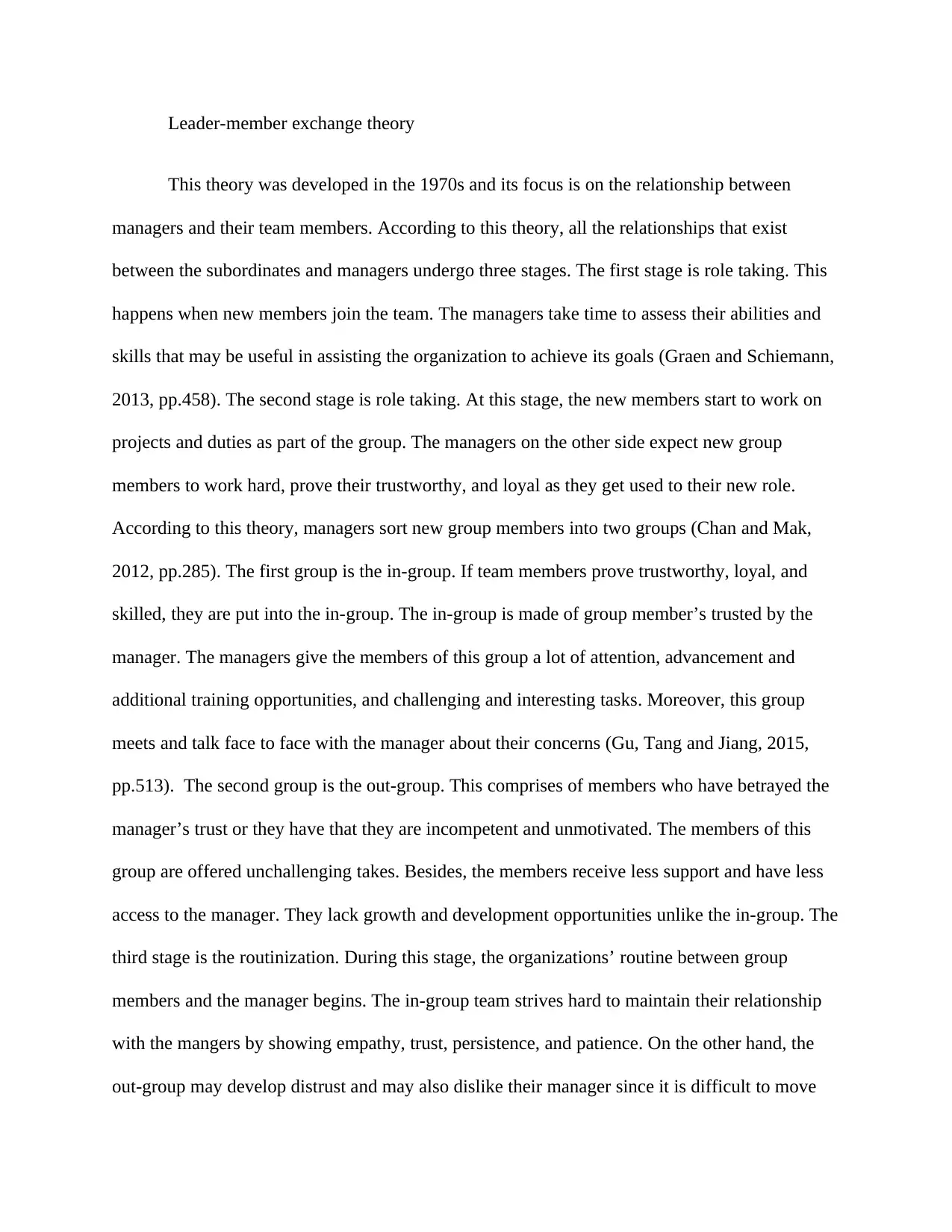
Leader-member exchange theory
This theory was developed in the 1970s and its focus is on the relationship between
managers and their team members. According to this theory, all the relationships that exist
between the subordinates and managers undergo three stages. The first stage is role taking. This
happens when new members join the team. The managers take time to assess their abilities and
skills that may be useful in assisting the organization to achieve its goals (Graen and Schiemann,
2013, pp.458). The second stage is role taking. At this stage, the new members start to work on
projects and duties as part of the group. The managers on the other side expect new group
members to work hard, prove their trustworthy, and loyal as they get used to their new role.
According to this theory, managers sort new group members into two groups (Chan and Mak,
2012, pp.285). The first group is the in-group. If team members prove trustworthy, loyal, and
skilled, they are put into the in-group. The in-group is made of group member’s trusted by the
manager. The managers give the members of this group a lot of attention, advancement and
additional training opportunities, and challenging and interesting tasks. Moreover, this group
meets and talk face to face with the manager about their concerns (Gu, Tang and Jiang, 2015,
pp.513). The second group is the out-group. This comprises of members who have betrayed the
manager’s trust or they have that they are incompetent and unmotivated. The members of this
group are offered unchallenging takes. Besides, the members receive less support and have less
access to the manager. They lack growth and development opportunities unlike the in-group. The
third stage is the routinization. During this stage, the organizations’ routine between group
members and the manager begins. The in-group team strives hard to maintain their relationship
with the mangers by showing empathy, trust, persistence, and patience. On the other hand, the
out-group may develop distrust and may also dislike their manager since it is difficult to move
This theory was developed in the 1970s and its focus is on the relationship between
managers and their team members. According to this theory, all the relationships that exist
between the subordinates and managers undergo three stages. The first stage is role taking. This
happens when new members join the team. The managers take time to assess their abilities and
skills that may be useful in assisting the organization to achieve its goals (Graen and Schiemann,
2013, pp.458). The second stage is role taking. At this stage, the new members start to work on
projects and duties as part of the group. The managers on the other side expect new group
members to work hard, prove their trustworthy, and loyal as they get used to their new role.
According to this theory, managers sort new group members into two groups (Chan and Mak,
2012, pp.285). The first group is the in-group. If team members prove trustworthy, loyal, and
skilled, they are put into the in-group. The in-group is made of group member’s trusted by the
manager. The managers give the members of this group a lot of attention, advancement and
additional training opportunities, and challenging and interesting tasks. Moreover, this group
meets and talk face to face with the manager about their concerns (Gu, Tang and Jiang, 2015,
pp.513). The second group is the out-group. This comprises of members who have betrayed the
manager’s trust or they have that they are incompetent and unmotivated. The members of this
group are offered unchallenging takes. Besides, the members receive less support and have less
access to the manager. They lack growth and development opportunities unlike the in-group. The
third stage is the routinization. During this stage, the organizations’ routine between group
members and the manager begins. The in-group team strives hard to maintain their relationship
with the mangers by showing empathy, trust, persistence, and patience. On the other hand, the
out-group may develop distrust and may also dislike their manager since it is difficult to move
Paraphrase This Document
Need a fresh take? Get an instant paraphrase of this document with our AI Paraphraser
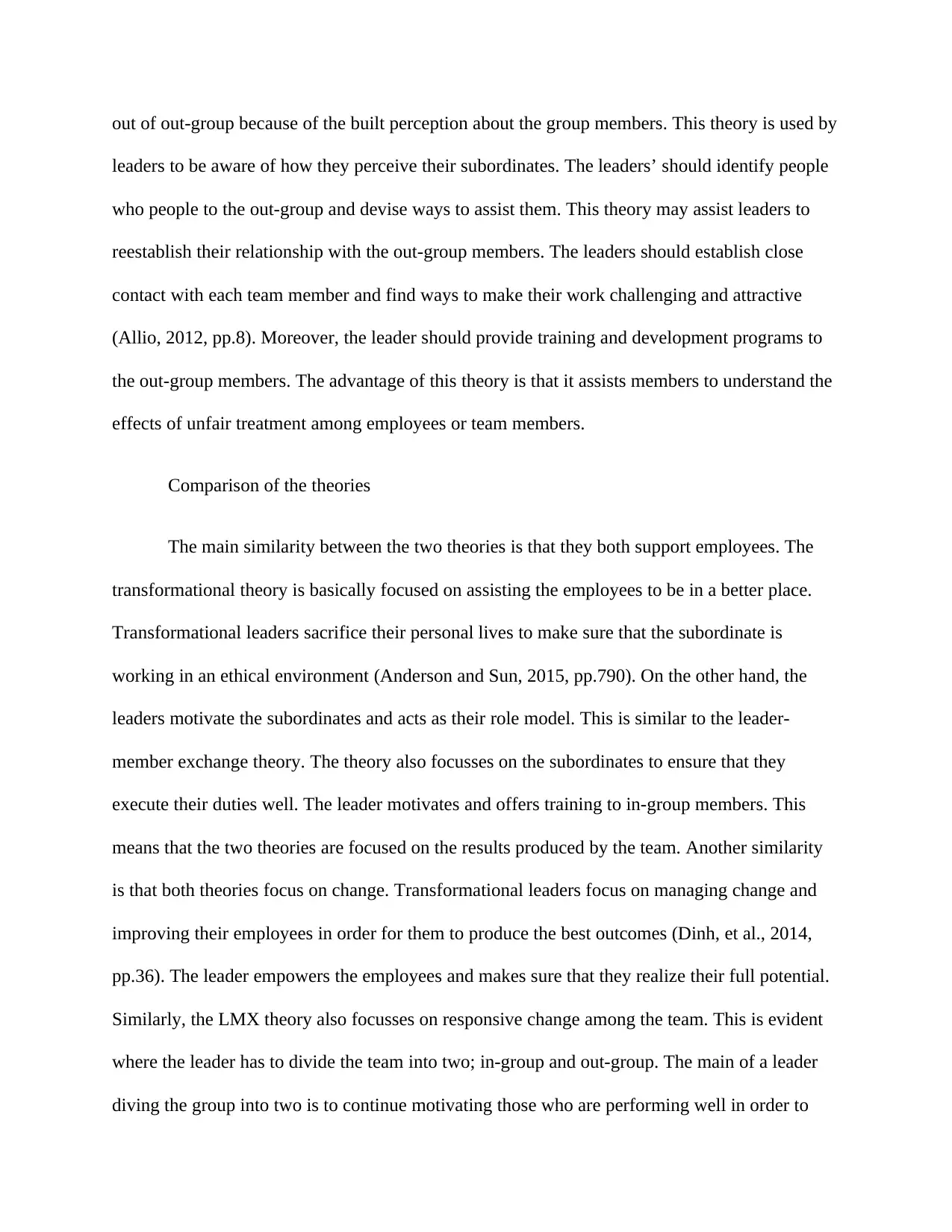
out of out-group because of the built perception about the group members. This theory is used by
leaders to be aware of how they perceive their subordinates. The leaders’ should identify people
who people to the out-group and devise ways to assist them. This theory may assist leaders to
reestablish their relationship with the out-group members. The leaders should establish close
contact with each team member and find ways to make their work challenging and attractive
(Allio, 2012, pp.8). Moreover, the leader should provide training and development programs to
the out-group members. The advantage of this theory is that it assists members to understand the
effects of unfair treatment among employees or team members.
Comparison of the theories
The main similarity between the two theories is that they both support employees. The
transformational theory is basically focused on assisting the employees to be in a better place.
Transformational leaders sacrifice their personal lives to make sure that the subordinate is
working in an ethical environment (Anderson and Sun, 2015, pp.790). On the other hand, the
leaders motivate the subordinates and acts as their role model. This is similar to the leader-
member exchange theory. The theory also focusses on the subordinates to ensure that they
execute their duties well. The leader motivates and offers training to in-group members. This
means that the two theories are focused on the results produced by the team. Another similarity
is that both theories focus on change. Transformational leaders focus on managing change and
improving their employees in order for them to produce the best outcomes (Dinh, et al., 2014,
pp.36). The leader empowers the employees and makes sure that they realize their full potential.
Similarly, the LMX theory also focusses on responsive change among the team. This is evident
where the leader has to divide the team into two; in-group and out-group. The main of a leader
diving the group into two is to continue motivating those who are performing well in order to
leaders to be aware of how they perceive their subordinates. The leaders’ should identify people
who people to the out-group and devise ways to assist them. This theory may assist leaders to
reestablish their relationship with the out-group members. The leaders should establish close
contact with each team member and find ways to make their work challenging and attractive
(Allio, 2012, pp.8). Moreover, the leader should provide training and development programs to
the out-group members. The advantage of this theory is that it assists members to understand the
effects of unfair treatment among employees or team members.
Comparison of the theories
The main similarity between the two theories is that they both support employees. The
transformational theory is basically focused on assisting the employees to be in a better place.
Transformational leaders sacrifice their personal lives to make sure that the subordinate is
working in an ethical environment (Anderson and Sun, 2015, pp.790). On the other hand, the
leaders motivate the subordinates and acts as their role model. This is similar to the leader-
member exchange theory. The theory also focusses on the subordinates to ensure that they
execute their duties well. The leader motivates and offers training to in-group members. This
means that the two theories are focused on the results produced by the team. Another similarity
is that both theories focus on change. Transformational leaders focus on managing change and
improving their employees in order for them to produce the best outcomes (Dinh, et al., 2014,
pp.36). The leader empowers the employees and makes sure that they realize their full potential.
Similarly, the LMX theory also focusses on responsive change among the team. This is evident
where the leader has to divide the team into two; in-group and out-group. The main of a leader
diving the group into two is to continue motivating those who are performing well in order to
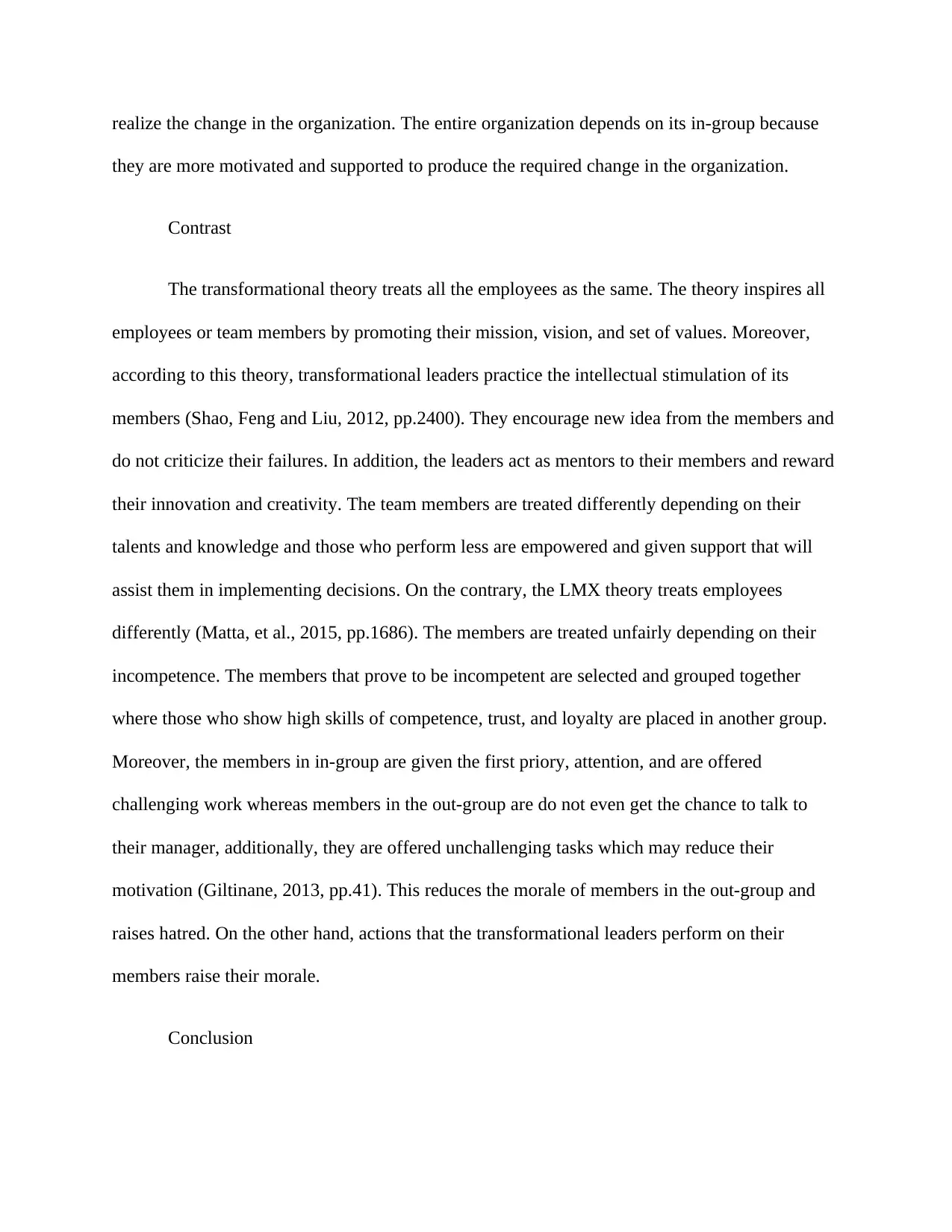
realize the change in the organization. The entire organization depends on its in-group because
they are more motivated and supported to produce the required change in the organization.
Contrast
The transformational theory treats all the employees as the same. The theory inspires all
employees or team members by promoting their mission, vision, and set of values. Moreover,
according to this theory, transformational leaders practice the intellectual stimulation of its
members (Shao, Feng and Liu, 2012, pp.2400). They encourage new idea from the members and
do not criticize their failures. In addition, the leaders act as mentors to their members and reward
their innovation and creativity. The team members are treated differently depending on their
talents and knowledge and those who perform less are empowered and given support that will
assist them in implementing decisions. On the contrary, the LMX theory treats employees
differently (Matta, et al., 2015, pp.1686). The members are treated unfairly depending on their
incompetence. The members that prove to be incompetent are selected and grouped together
where those who show high skills of competence, trust, and loyalty are placed in another group.
Moreover, the members in in-group are given the first priory, attention, and are offered
challenging work whereas members in the out-group are do not even get the chance to talk to
their manager, additionally, they are offered unchallenging tasks which may reduce their
motivation (Giltinane, 2013, pp.41). This reduces the morale of members in the out-group and
raises hatred. On the other hand, actions that the transformational leaders perform on their
members raise their morale.
Conclusion
they are more motivated and supported to produce the required change in the organization.
Contrast
The transformational theory treats all the employees as the same. The theory inspires all
employees or team members by promoting their mission, vision, and set of values. Moreover,
according to this theory, transformational leaders practice the intellectual stimulation of its
members (Shao, Feng and Liu, 2012, pp.2400). They encourage new idea from the members and
do not criticize their failures. In addition, the leaders act as mentors to their members and reward
their innovation and creativity. The team members are treated differently depending on their
talents and knowledge and those who perform less are empowered and given support that will
assist them in implementing decisions. On the contrary, the LMX theory treats employees
differently (Matta, et al., 2015, pp.1686). The members are treated unfairly depending on their
incompetence. The members that prove to be incompetent are selected and grouped together
where those who show high skills of competence, trust, and loyalty are placed in another group.
Moreover, the members in in-group are given the first priory, attention, and are offered
challenging work whereas members in the out-group are do not even get the chance to talk to
their manager, additionally, they are offered unchallenging tasks which may reduce their
motivation (Giltinane, 2013, pp.41). This reduces the morale of members in the out-group and
raises hatred. On the other hand, actions that the transformational leaders perform on their
members raise their morale.
Conclusion
⊘ This is a preview!⊘
Do you want full access?
Subscribe today to unlock all pages.

Trusted by 1+ million students worldwide
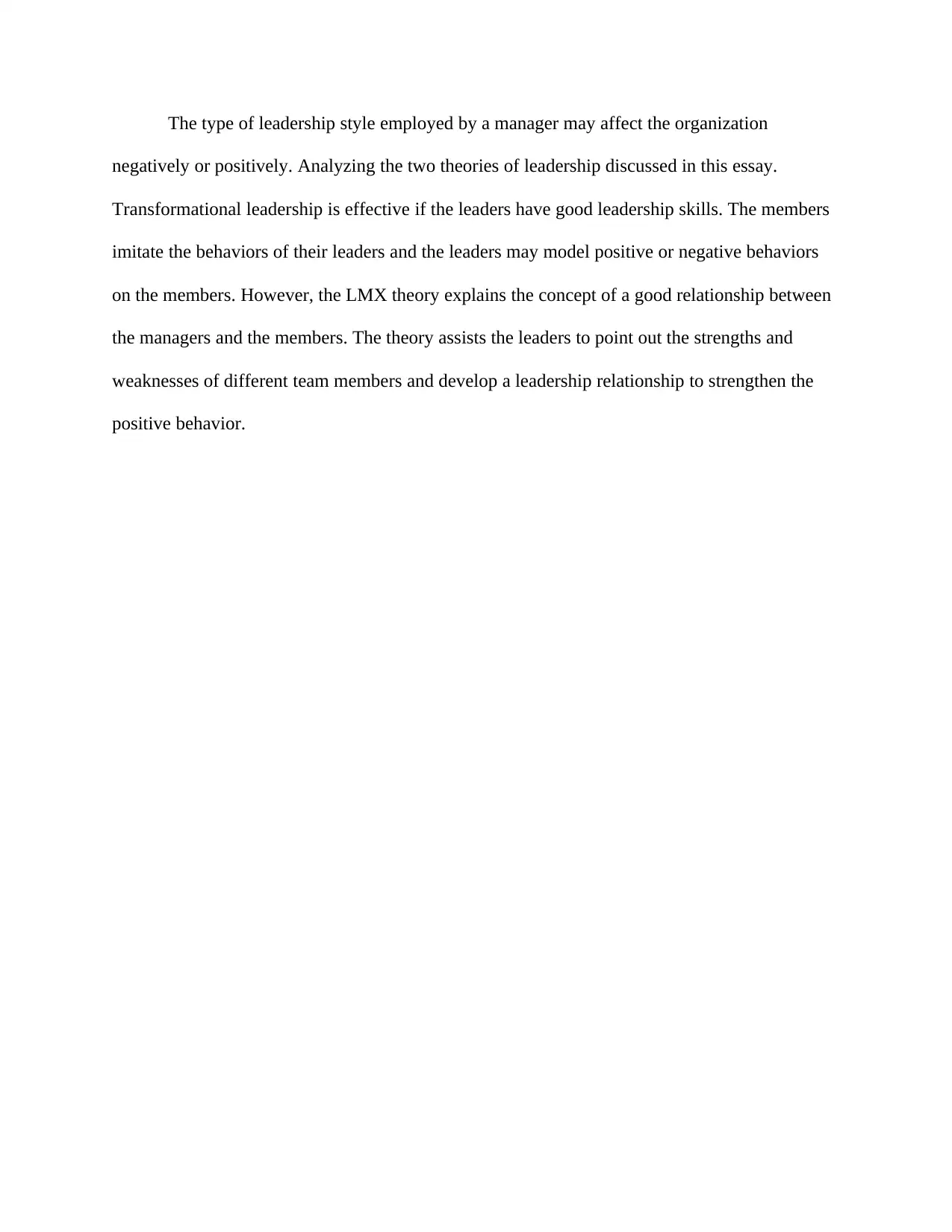
The type of leadership style employed by a manager may affect the organization
negatively or positively. Analyzing the two theories of leadership discussed in this essay.
Transformational leadership is effective if the leaders have good leadership skills. The members
imitate the behaviors of their leaders and the leaders may model positive or negative behaviors
on the members. However, the LMX theory explains the concept of a good relationship between
the managers and the members. The theory assists the leaders to point out the strengths and
weaknesses of different team members and develop a leadership relationship to strengthen the
positive behavior.
negatively or positively. Analyzing the two theories of leadership discussed in this essay.
Transformational leadership is effective if the leaders have good leadership skills. The members
imitate the behaviors of their leaders and the leaders may model positive or negative behaviors
on the members. However, the LMX theory explains the concept of a good relationship between
the managers and the members. The theory assists the leaders to point out the strengths and
weaknesses of different team members and develop a leadership relationship to strengthen the
positive behavior.
Paraphrase This Document
Need a fresh take? Get an instant paraphrase of this document with our AI Paraphraser
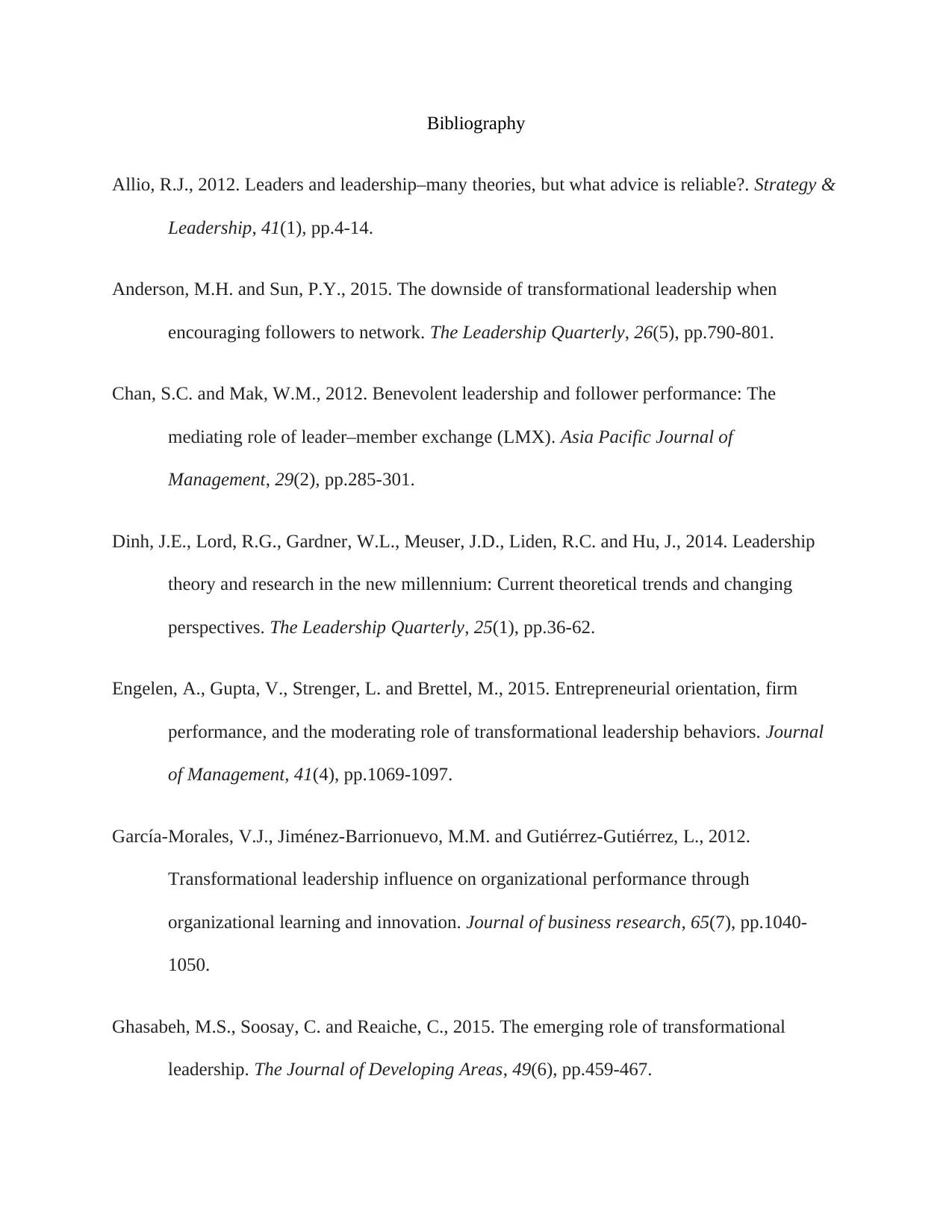
Bibliography
Allio, R.J., 2012. Leaders and leadership–many theories, but what advice is reliable?. Strategy &
Leadership, 41(1), pp.4-14.
Anderson, M.H. and Sun, P.Y., 2015. The downside of transformational leadership when
encouraging followers to network. The Leadership Quarterly, 26(5), pp.790-801.
Chan, S.C. and Mak, W.M., 2012. Benevolent leadership and follower performance: The
mediating role of leader–member exchange (LMX). Asia Pacific Journal of
Management, 29(2), pp.285-301.
Dinh, J.E., Lord, R.G., Gardner, W.L., Meuser, J.D., Liden, R.C. and Hu, J., 2014. Leadership
theory and research in the new millennium: Current theoretical trends and changing
perspectives. The Leadership Quarterly, 25(1), pp.36-62.
Engelen, A., Gupta, V., Strenger, L. and Brettel, M., 2015. Entrepreneurial orientation, firm
performance, and the moderating role of transformational leadership behaviors. Journal
of Management, 41(4), pp.1069-1097.
García-Morales, V.J., Jiménez-Barrionuevo, M.M. and Gutiérrez-Gutiérrez, L., 2012.
Transformational leadership influence on organizational performance through
organizational learning and innovation. Journal of business research, 65(7), pp.1040-
1050.
Ghasabeh, M.S., Soosay, C. and Reaiche, C., 2015. The emerging role of transformational
leadership. The Journal of Developing Areas, 49(6), pp.459-467.
Allio, R.J., 2012. Leaders and leadership–many theories, but what advice is reliable?. Strategy &
Leadership, 41(1), pp.4-14.
Anderson, M.H. and Sun, P.Y., 2015. The downside of transformational leadership when
encouraging followers to network. The Leadership Quarterly, 26(5), pp.790-801.
Chan, S.C. and Mak, W.M., 2012. Benevolent leadership and follower performance: The
mediating role of leader–member exchange (LMX). Asia Pacific Journal of
Management, 29(2), pp.285-301.
Dinh, J.E., Lord, R.G., Gardner, W.L., Meuser, J.D., Liden, R.C. and Hu, J., 2014. Leadership
theory and research in the new millennium: Current theoretical trends and changing
perspectives. The Leadership Quarterly, 25(1), pp.36-62.
Engelen, A., Gupta, V., Strenger, L. and Brettel, M., 2015. Entrepreneurial orientation, firm
performance, and the moderating role of transformational leadership behaviors. Journal
of Management, 41(4), pp.1069-1097.
García-Morales, V.J., Jiménez-Barrionuevo, M.M. and Gutiérrez-Gutiérrez, L., 2012.
Transformational leadership influence on organizational performance through
organizational learning and innovation. Journal of business research, 65(7), pp.1040-
1050.
Ghasabeh, M.S., Soosay, C. and Reaiche, C., 2015. The emerging role of transformational
leadership. The Journal of Developing Areas, 49(6), pp.459-467.
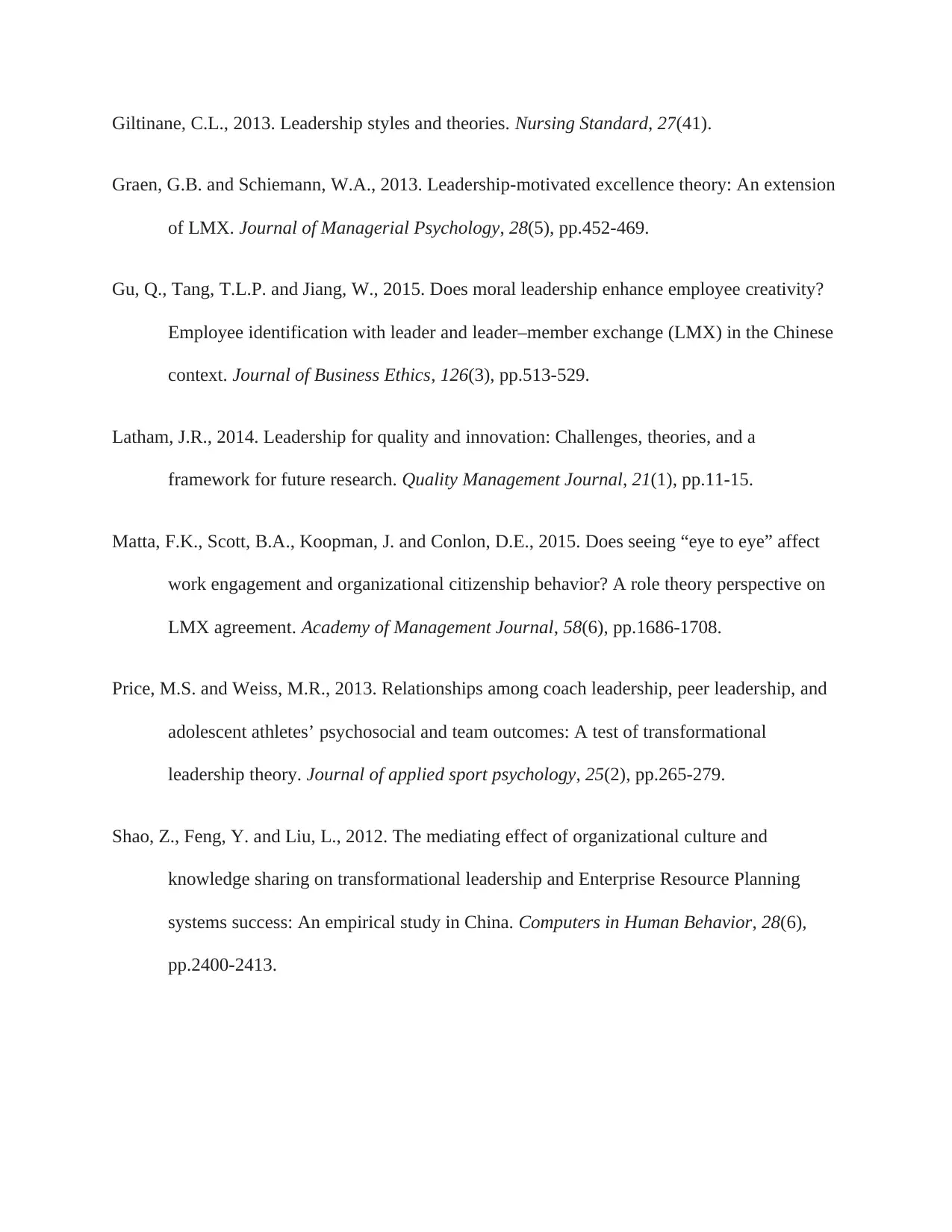
Giltinane, C.L., 2013. Leadership styles and theories. Nursing Standard, 27(41).
Graen, G.B. and Schiemann, W.A., 2013. Leadership-motivated excellence theory: An extension
of LMX. Journal of Managerial Psychology, 28(5), pp.452-469.
Gu, Q., Tang, T.L.P. and Jiang, W., 2015. Does moral leadership enhance employee creativity?
Employee identification with leader and leader–member exchange (LMX) in the Chinese
context. Journal of Business Ethics, 126(3), pp.513-529.
Latham, J.R., 2014. Leadership for quality and innovation: Challenges, theories, and a
framework for future research. Quality Management Journal, 21(1), pp.11-15.
Matta, F.K., Scott, B.A., Koopman, J. and Conlon, D.E., 2015. Does seeing “eye to eye” affect
work engagement and organizational citizenship behavior? A role theory perspective on
LMX agreement. Academy of Management Journal, 58(6), pp.1686-1708.
Price, M.S. and Weiss, M.R., 2013. Relationships among coach leadership, peer leadership, and
adolescent athletes’ psychosocial and team outcomes: A test of transformational
leadership theory. Journal of applied sport psychology, 25(2), pp.265-279.
Shao, Z., Feng, Y. and Liu, L., 2012. The mediating effect of organizational culture and
knowledge sharing on transformational leadership and Enterprise Resource Planning
systems success: An empirical study in China. Computers in Human Behavior, 28(6),
pp.2400-2413.
Graen, G.B. and Schiemann, W.A., 2013. Leadership-motivated excellence theory: An extension
of LMX. Journal of Managerial Psychology, 28(5), pp.452-469.
Gu, Q., Tang, T.L.P. and Jiang, W., 2015. Does moral leadership enhance employee creativity?
Employee identification with leader and leader–member exchange (LMX) in the Chinese
context. Journal of Business Ethics, 126(3), pp.513-529.
Latham, J.R., 2014. Leadership for quality and innovation: Challenges, theories, and a
framework for future research. Quality Management Journal, 21(1), pp.11-15.
Matta, F.K., Scott, B.A., Koopman, J. and Conlon, D.E., 2015. Does seeing “eye to eye” affect
work engagement and organizational citizenship behavior? A role theory perspective on
LMX agreement. Academy of Management Journal, 58(6), pp.1686-1708.
Price, M.S. and Weiss, M.R., 2013. Relationships among coach leadership, peer leadership, and
adolescent athletes’ psychosocial and team outcomes: A test of transformational
leadership theory. Journal of applied sport psychology, 25(2), pp.265-279.
Shao, Z., Feng, Y. and Liu, L., 2012. The mediating effect of organizational culture and
knowledge sharing on transformational leadership and Enterprise Resource Planning
systems success: An empirical study in China. Computers in Human Behavior, 28(6),
pp.2400-2413.
⊘ This is a preview!⊘
Do you want full access?
Subscribe today to unlock all pages.

Trusted by 1+ million students worldwide

Van Knippenberg, D. and Sitkin, S.B., 2013. A critical assessment of charismatic—
transformational leadership research: Back to the drawing board?. The Academy of
Management Annals, 7(1), pp.1-60.
transformational leadership research: Back to the drawing board?. The Academy of
Management Annals, 7(1), pp.1-60.
1 out of 10
Related Documents
Your All-in-One AI-Powered Toolkit for Academic Success.
+13062052269
info@desklib.com
Available 24*7 on WhatsApp / Email
![[object Object]](/_next/static/media/star-bottom.7253800d.svg)
Unlock your academic potential
Copyright © 2020–2025 A2Z Services. All Rights Reserved. Developed and managed by ZUCOL.




